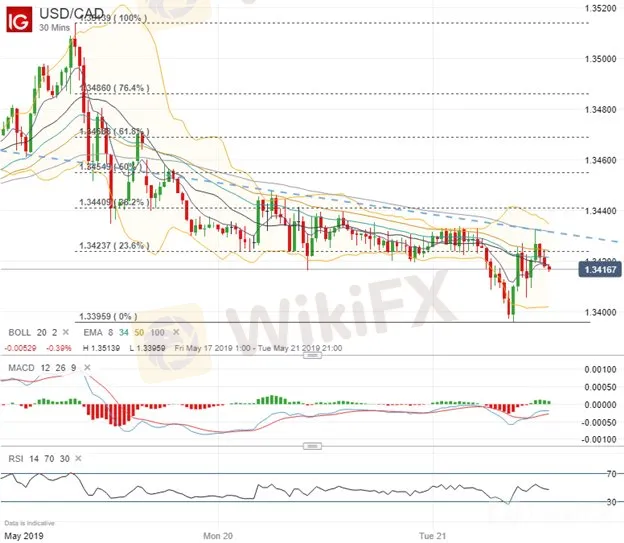简体中文
繁體中文
English
Pусский
日本語
ภาษาไทย
Tiếng Việt
Bahasa Indonesia
Español
हिन्दी
Filippiiniläinen
Français
Deutsch
Português
Türkçe
한국어
العربية
USDCAD: USD Eyes Powell & Fed, CAD Climbs on USMCA & Oil
Abstract:The Canadian Dollar climbs on the back of recent USMCA tailwinds and oil price gains, but the prospect of hawkish FOMC minutes due Wednesday threatens to keep USD bid.
USDCAD – TALKING POINTS
USDCAD slid toward the 1.3400 handle as positive developments around USMCA and oil prices benefit the Canadian Dollar
Fed meeting minutes on deck for release Wednesday risks a possible reversal higher in spot prices
{3}
Find out How to Tell When a Currency Pair is Changing its Trend
{3}
USDCAD dipped to the 1.3400 handle as upbeat USMCA news continues to put downward pressure on the currency pair. The recent move lower in USDCAD was likely exacerbated by gains in oil following reports that OPEC production cuts will be extended while recent Iranian conflict could further threaten global oil supply.
USDCAD PRICE CHART: 30-MINUTE TIME FRAME (MAY 17, 2019 TO MAY 21, 2019)

Although the Canadian Dollar looks to continue benefiting from an impending trade deal with the United States in addition to climbing oil prices, further downside in spot USDCAD could be limited over the short-term. One notable technical development during Tuesdays session was the sharp rebound higher USDCAD notched after touching the 1.3400 price level – a major area of confluence which looks to serve as technical support.
If spot USDCAD continues to creep higher and breaks above the negative-sloping trendline drawn along the series of lower highs since last Friday, it might signal that the latest push lower in USDCAD may be running out of steam. This possible scenario could grow increasingly likely if the forex rate also overcomes technical resistance posed by the 23.6 percent and 38.2 percent Fibonacci retracement levels shown above.
USDCAD PRICE CHART: WEEKLY TIME FRAME (SEPTEMBER 16, 2018 TO MAY 21, 2019)

Looking at USDCAD with a broader perspective, spot prices also face resistance from the 23.6 percent Fibonacci retracement level drawn from the respective low and high in October and December last year. Yet the currency pair has failed to hold its footing below the 38.2 percent Fib since spot prices reclaimed the 1.3330 level back in March.
Moreover, a tight coil has formed between bullish uptrend and bearish downtrend lines which supplements the recent consolidation in USDCAD around the 1.3400 handle. This area of confluence could be put to the test in the near future, however, as conflicting upside and downside risks begin to unfold.
While the removal of US tariffs on Canadian steel exports boosts bullish prospects for the loonie along with rising oil prices, USDCAD downside could be offset by a sharp rise in the greenback if a hawkish Fed is revealed in the FOMC minutes release due Wednesday at 18:00 GMT.
- Written by Rich Dvorak, Junior Analyst for DailyFX
- Follow @RichDvorakFX on Twitter
Disclaimer:
The views in this article only represent the author's personal views, and do not constitute investment advice on this platform. This platform does not guarantee the accuracy, completeness and timeliness of the information in the article, and will not be liable for any loss caused by the use of or reliance on the information in the article.
Read more

KVB Market Analysis | 30 August: JPY Strengthens Against USD Amid Strong Q2 GDP and BoJ Rate Hike Speculation
The Japanese Yen (JPY) strengthened against the US Dollar (USD) on Thursday, boosted by stronger-than-expected Q2 GDP growth in Japan, raising hopes for a BoJ rate hike. Despite this, the USD/JPY pair found support from higher US Treasury yields, though gains may be capped by expectations of a Fed rate cut in September.

NFP Hammers Dollar to 4 Months Low
The aftermath of the Japanese yen's strengthening has manifested in significant dips across multiple markets, including equities, commodities, and various currencies. The yen has erased all its 2024 losses against the dollar, moving towards the 145.00 mark. The dollar index (DXY) has fallen to its lowest level since March, hovering above the $103 mark.

Key Economic Calendar Events for This Week (August 5-9, 2024)
This week's economic events include: Japan's Monetary Policy Minutes and U.S. Services PMI on Monday, impacting JPY and USD. Tuesday's RBA Interest Rate Decision affects AUD, with German Factory Orders influencing EUR. Wednesday sees German Industrial Production and U.S. Crude Inventories impacting EUR and USD. Thursday: RBA Governor speaks, with U.S. Jobless Claims. Friday: China's CPI and Canada's Unemployment Rate affect CNY and CAD.

Anticipating the Nonfarm Payroll Report
As we approach the Nonfarm Payroll (NFP) report on August 2, 2024, market participants are keenly observing the data for insights into the U.S. labor market. The report is expected to show an increase of 194,000 to 206,000 jobs for July, indicating modest growth. This suggests potential softening in the labor market. A weaker-than-expected report could prompt the Fed to consider rate cuts, influencing the USD. Major currency pairs and gold prices will likely see volatility around the NFP release
WikiFX Broker
Latest News
AIMS Broker Review
The Hidden Checklist: Five Unconventional Steps to Vet Your Broker
Russia to Fully Ban Crypto Mining in 10 Regions Starting January 1, 2025
YAMARKETS' Jingle Bells Christmas Offer!
Why is there so much exposure against PrimeX Capital?
Two Californians Indicted for $22 Million Crypto and NFT Fraud
WikiFX Review: Is Ultima Markets Legit?
Colorado Duo Accused of $8M Investment Fraud Scheme
MTrading’s 2025 "Welcome Bonus" is Here
FCA's Warning to Brokers: Don't Ignore!
Currency Calculator



